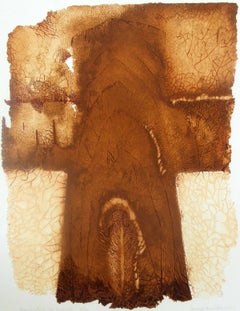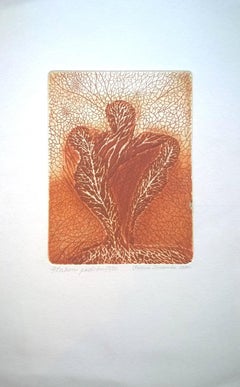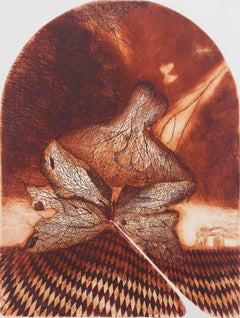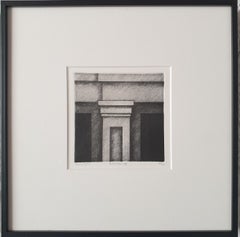Irena Snarska Prints and Multiples
b. 1934
Irena Snarska was born in 1934 in Lviv. She studied at the Faculty of Interior Architecture at the Academy of Fine Arts in Warsaw. Between 1956–62, she studied graphic arts under prof. Andrzej Rudziński. She received her diploma in 1962 from the legendary studio of book illustration of prof. Jan Marcin Szancer. Since 1972, she was a professor at the Faculty of Graphic Arts of the Warsaw Academy.
to
6
6
2
4
Overall Height
to
Overall Width
to
1
4
2
1
3
6
986
695
659
626
6
6
Artist: Irena Snarska
According to Milosz's poetry - XX Century, Figurative Etching Print, Colorful
By Irena Snarska
Located in Warsaw, PL
Irena Snarska (b. 1934, d. 2013)
Irena Snarska was born in 1934 in Lviv. She studied at the Faculty of Interior Architecture at the Academy of Fine Arts in Warsaw. Between 1956 and 1...
Category
1980s Other Art Style Irena Snarska Prints and Multiples
Materials
Paper, Etching
Analysis - XX Century, Abstract Etching Print, Organic Shapes, Leaf
By Irena Snarska
Located in Warsaw, PL
Irena Snarska (b. 1934, d. 2013)
Irena Snarska was born in 1934 in Lviv. She studied at the Faculty of Interior Architecture at the Academy of Fine Arts in Warsaw. Between 1956 and 1...
Category
Early 2000s Other Art Style Irena Snarska Prints and Multiples
Materials
Paper, Etching
Souvenir - XX Century, Abstract Etching Print, Monochromatic, Organic Shapes
By Irena Snarska
Located in Warsaw, PL
Irena Snarska (b. 1934, d. 2013)
Irena Snarska was born in 1934 in Lviv. She studied at the Faculty of Interior Architecture at the Academy of Fine Arts in Warsaw. Between 1956 and 1...
Category
1990s Other Art Style Irena Snarska Prints and Multiples
Materials
Paper, Etching
Similar to birds - XX Century, Abstract Etching Print, Organic Shapes
By Irena Snarska
Located in Warsaw, PL
Irena Snarska (b. 1934, d. 2013)
Irena Snarska was born in 1934 in Lviv. She studied at the Faculty of Interior Architecture at the Academy of Fine Arts in Warsaw. Between 1956 and 1...
Category
1990s Other Art Style Irena Snarska Prints and Multiples
Materials
Paper, Etching
Chopin's mazurka - XX Century, Abstract Etching Print, Monochromatic, Piano keys
By Irena Snarska
Located in Warsaw, PL
Irena Snarska (b. 1934, d. 2013)
Irena Snarska was born in 1934 in Lviv. She studied at the Faculty of Interior Architecture at the Academy of Fine Arts in Warsaw. Between 1956 and 1...
Category
Early 2000s Other Art Style Irena Snarska Prints and Multiples
Materials
Paper, Etching
Butterfly's tragedy - XX Century, Abstract Etching Print, Monochromatic
By Irena Snarska
Located in Warsaw, PL
Irena Snarska (b. 1934, d. 2013)
Irena Snarska was born in 1934 in Lviv. She studied at the Faculty of Interior Architecture at the Academy of Fine Arts in Warsaw. Between 1956 and 1...
Category
1990s Other Art Style Irena Snarska Prints and Multiples
Materials
Paper, Etching
Related Items
Salvador Dali - Fight Before la Dame - Original Handsigned Etching
By Salvador Dalí
Located in Collonge Bellerive, Geneve, CH
Salvador Dali - Original Handsigned Etching
From La Quête du Graal
Dimensions: 45 x 33 cm
Handsigned
Edition: 38/100
(from the rare deluxe suite aside from the standard edition)
Cat...
Category
1970s Surrealist Irena Snarska Prints and Multiples
Materials
Etching
H 17.72 in W 13 in D 0.4 in
Amsterdam VI ed 28/50- museum glass framed black-white aquatint etch print
By Olivier Julia
Located in Doetinchem, NL
Amsterdam VI is an intriguing early career aquatint dry-needle etch print by renowned French-Dutch artist Olivier Julia. It depicts a detail of an old Amsterdam house facade is both ...
Category
1980s Contemporary Irena Snarska Prints and Multiples
Materials
Rag Paper, Etching, Aquatint
fern-butterfly effect f-1
By Seiko Tachibana
Located in Palm Springs, CA
Medium: intaglio
Year: 2015
Signed Artist Proof from the edition of 25
Image Size: 7.5 x 6 inches
Paper Size: 15 x 11 inches
Signed and numbered by the artist.
Seiko Tachibana's...
Category
2010s Abstract Geometric Irena Snarska Prints and Multiples
Materials
Etching, Aquatint
Amsterdam VIII ed 28/50 - museum glass framed black-white aquatint etch print
By Olivier Julia
Located in Doetinchem, NL
Amsterdam VIII is an intriguing early career aquatint dry-needle etch print by renowned French-Dutch artist Olivier Julia. It depicts a detail of an old Amsterdam house facade is bot...
Category
1980s Contemporary Irena Snarska Prints and Multiples
Materials
Rag Paper, Etching, Aquatint
Amsterdam IX ed 28/50 - museum glass framed black-white aquatint etch print
By Olivier Julia
Located in Doetinchem, NL
Amsterdam IX is an intriguing early career aquatint dry-needle etch print by renowned French-Dutch artist Olivier Julia. It depicts a detail of an old Amsterdam house facade is both ...
Category
1980s Contemporary Irena Snarska Prints and Multiples
Materials
Rag Paper, Etching, Aquatint
Amsterdam II ed 28/50- museum glass framed black-white aquatint etch print
By Olivier Julia
Located in Doetinchem, NL
Amsterdam II is an intriguing early career aquatint dry-needle etch print by renowned French-Dutch artist Olivier Julia. It depicts a detail of an old Amsterdam house facade is both ...
Category
1980s Contemporary Irena Snarska Prints and Multiples
Materials
Rag Paper, Etching, Aquatint
Samuel Bak Surrealist Etching Israeli Bezalel Artist "Hidden Pear", Fruit Bowl
By Samuel Bak
Located in Surfside, FL
HIDDEN PEAR, color etching, signed in pencil, numbered 7/50, Jerusalem Print workshop blind stamp, image 7 ½ x 5 ½”, sheet 15 x 10 ¼”.
Samuel Bak (born 12 August 1933) is a Polish- American painter and writer who survived the Holocaust and immigrated to Israel in 1948. Since 1993, he has lived in the United States.
Samuel Bak was born in Wilno, Poland, Bak was recognized from an early age as having an artistic talent. He describes his family as secular, but proud of their Jewish identity.
By 1939 when Bak was six years old, the war began and Wilno was transferred from Poland to Lithuania. When Wilno was occupied by the Germans on June 24, 1941, Bak and his family were forced to move into the ghetto. At the age of nine, he held his first exhibition inside the Ghetto. Bak and his mother sought refuge in a Benedictine convent where a Catholic nun named Maria Mikulska tried to help them. After returning to the ghetto, they were deported to a forced labour camp, but took shelter again in the convent where they remained in hiding until the end of the war.
By the end of the war, Samuel and his mother were the only members of his extensive family to survive. His father, Jonas, was shot by the Germans in July 1944, only a few days before Samuel's own liberation. As Bak described the situation, "when in 1944 the Soviets liberated us, we were two among two hundred of Vilna's survivors--from a community that had counted 70 or 80 thousand." Bak and his mother as pre-war Polish citizens were allowed to leave Soviet-occupied Wilno and travel to central Poland, at first settling briefly in Lodz. They soon left Poland and traveled into the American occupied zone of Germany. From 1945 to 1948, he and his mother lived in Displaced Persons camps in Germany. He spent most of this period at the Landsberg am Lech DP camp in Germany. It was there he painted a self-portrait shortly before repudiating his Bar Mitzvah ceremony. Bak also studied painting in Munich during this period, and painted "A Mother and Son", 1947, which evokes some of his dark memories of the Holocaust and escape from Soviet-occupied Poland. In 1948, Bak and his mother immigrated to Israel. In 1952, he studied art at the Bezalel Academy of Arts and Design in Jerusalem. After serving in the Israel Defense Forces, he continued his studies in Paris (from 1956 at the École nationale supérieure des Beaux-Arts) and spent various periods of time in Rome, Paris, Switzerland and Israel before settling permanently in the United States. In 2001, Bak returned to Vilnius for the first time and has since visited his hometown several times. Samuel Bak is a conceptual artist with elements of post-modernism as he employs different styles and visual vernaculars, i.e. surrealism (Salvador Dali, Rene Magritte), analytical cubism (Picasso), pop art (Andy Warhol, Roy Lichtenstein) and quotations from the old masters. The artist never paints direct scenes of mass death. Instead, he employs allegory, metaphor and certain artistic devices such as substitution: toys instead of the murdered children who played with them, books, instead of the people who read them. Further devices are quotations of iconographical prototypes, i.e. Michelangelo's "Creation of Adam" on the Sistine Ceiling or Albrecht Dürer's famous engraving entitled "Melencholia" . In the late 1980s Bak opened up about his paintings, stating they convey “a sense of a world that was shattered.” He turns these prototypes into ironical statements. Irony in the art of Samuel Bak does not mean parody or derision, but rather disenchantment, and the attempt to achieve distance from pain. Recurring symbols are: the Warsaw Ghetto Child, Crematorium Chimneys or vast backgrounds of Renaissance landscape that symbolize the indifference of the outside world. These form a disturbing contrast with the broken and damaged images in the foreground. Samuel Bak's paintings cause discomfort, they are a warning against complacency, a bulwark against collective amnesia with reference to all acts of barbarism, worldwide and throughout the ages, through his personal experience of genocide.
In Bak's piece entitled Trains Bak creates a vast grey landscape with large mounts creating the structure of a train. Massive taper candles burn in the distance further down the train tracks, surrounding an eruption. The smoke from the candles and volcano pour into a sky of dark ominous clouds that lurk over the landscape. Here Bak has created a whole new meaning for “trains.” Many of Bak’s pieces incorporate aspects of Jewish culture and the holocaust with a dark and creative twist, such as Shema Israel, Alone, and Ghetto. Chess as a theme of life has always fascinated Bak. In the DP camps and in Israel, he often played chess with his stepfather Markusha. Underground II, 1997, portrays chess pieces in a sunken, subterranean evocation of the Vilna ghetto.
Select Group Exhibitions
Graphic Works by Contemporary Israeli artists - Israel Museum, Jerusalem
Avraham Ofek, Igael Tumarkin, Shmuel Bak, Avigdor Arikha,Jakob Steinhardt, Anna Ticho
Artist and Society in Israeli Art, Tel Aviv Museum, Tel Aviv Moshe Gat, Marcel Janco, Yohanan Simon, Ruth Schloss, Menashe Kadishman, Samuel Bak, Yosl Bergner.
Selected museum exhibitions
Bezalel Museum, Jerusalem, Israel – 1963
Tel Aviv Museum, Tel Aviv, Israel – 1963
Rose Museum, Brandeis University, Waltham, MA – 1976
Germanisches National Museum, Nuremberg, Germany – 1977
Heidelberg Museum, Heidelberg, Germany – 1977
Haifa University, Haifa, Israel – 1978
Kunstmuseum, Düsseldorf, Germany – 1978
Jüdisches Museum, Stadt Frankfurt am Main, Germany – 1993
Hebrew Union College, Jewish Institute of Religion, New York, NY – 1994
South African Jewish Museum, Cape Town, South Africa. 2013-2014.
B’nai B’rith Klutznick National Jewish Museum, Washington, DC – 1997
Holocaust Museum Houston, Houston, TX – 1997
National Museum of Lithuania, Vilnius, Lithuania – 2001
Felix Nussbaum...
Category
20th Century Surrealist Irena Snarska Prints and Multiples
Materials
Etching
Amsterdam III ed 28/50 - museum glass framed black-white aquatint etch print
By Olivier Julia
Located in Doetinchem, NL
Amsterdam III is an intriguing early career aquatint dry-needle etch print by renowned French-Dutch artist Olivier Julia. It depicts a detail of an old Amsterdam house facade is both...
Category
1980s Contemporary Irena Snarska Prints and Multiples
Materials
Rag Paper, Etching, Aquatint
Amsterdam V ed 27/50 - museum glass framed black-white aquatint etch print
By Olivier Julia
Located in Doetinchem, NL
Amsterdam V is an intriguing early career aquatint dry-needle etch print by renowned French-Dutch artist Olivier Julia. It depicts a detail of an old Amsterdam house facade is both a...
Category
1980s Contemporary Irena Snarska Prints and Multiples
Materials
Rag Paper, Etching, Aquatint
Venice 4/50 - collectors box with ten black-white etching aquatint prints
By Olivier Julia
Located in Doetinchem, NL
Venezia (Venice) is a unique collectors box for everyone with an interest in contemporary modern minimalist prints. This custom made box contains 10 small etching aquatint prints depicting details of old Venice building...
Category
1980s Minimalist Irena Snarska Prints and Multiples
Materials
Rag Paper, Etching, Aquatint
H 10.63 in W 10.63 in D 0.79 in
Israeli Modernist Surrealist Etching Cut Pear
By Shlomo Zafrir
Located in Surfside, FL
20.75x14.5 sheet size. 9.5x7.75 image size
Shlomo Zafrir is active/lives in Israel, France. Shlomo Zafrir is known for cubist painting.
Shlomo Zafrir is a painter and, at the same t...
Category
20th Century Surrealist Irena Snarska Prints and Multiples
Materials
Etching
Amsterdam I ed 28/50 - museum glass framed black-white aquatint etch print
By Olivier Julia
Located in Doetinchem, NL
Amsterdam I is an intriguing early career aquatint dry-needle etch print by renowned French-Dutch artist Olivier Julia. It depicts a detail of an old Amsterdam house facade is both a...
Category
1980s Contemporary Irena Snarska Prints and Multiples
Materials
Rag Paper, Etching, Aquatint
Irena Snarska prints and multiples for sale on 1stDibs.
Find a wide variety of authentic Irena Snarska prints and multiples available for sale on 1stDibs. You can also browse by medium to find art by Irena Snarska in etching, paper and more. Not every interior allows for large Irena Snarska prints and multiples, so small editions measuring 5 inches across are available. Customers who are interested in this artist might also find the work of Diane Williams, Marc Balakjian, and Francisco Souto. Irena Snarska prints and multiples prices can differ depending upon medium, time period and other attributes. On 1stDibs, the price for these items starts at $391 and tops out at $670, while the average work can sell for $475.







